HISTORY 135F
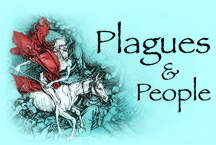
Infectious and
Epidemic Disease in History
Department of History
University of California, Irvine
Instructor: Dr. Barbara J. Becker
HISTORY 135F

Infectious and
Epidemic Disease in History
Department of History
University of California, Irvine
Instructor: Dr. Barbara J. Becker
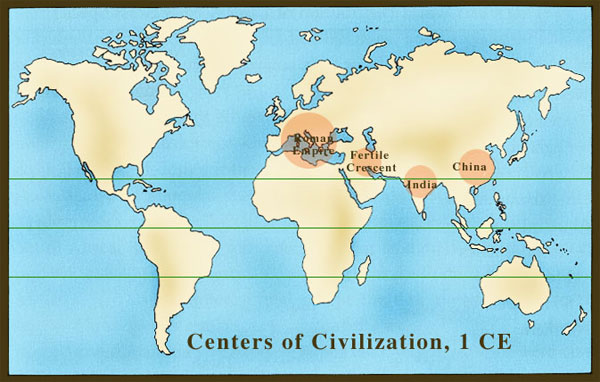
| Early European Epidemics |
|
|
Plague of Athens
|
|
scarlet fever? smallpox? |
Plague of Antoninus
|
|
|
Plague of St. Cyprian*
|
|
dysentery? |
|
Many of us are dying in this mortality, that is many of us are being freed
from the world. This mortality is a bane to the Jews and pagans and
enemies of Christ; to the servants of God it is a salutary departure.
As to the fact that without any discrimination in the human race the just are dying with the unjust, it is not for you to think that the destruction is a common one for both the evil and the good. The just are called to refreshment, the unjust are carried off to torture; protection is more quickly given to the faithful; punishment to the faithless.... How suitable, how necessary it is that this plague and pestilence, which seems horrible and deadly, searches out the justice of each and every one and examines the minds of the human race.... --St. Cyprian (251) |
| Notable Events during the "Dark" Ages (500-1000 CE) |
|
| Fall of Rome | |
| Major eruption of Mt. Vesuvius | |
| Major earthquake in Antioch | |
| First Pandemic (bubonic plague)
Plague of Justinian (Constantinople) · allegedly originated in Egyptian city of Pelusium · recorded by eyewitness and historian, Procopius (500-560) · killed 40% of population in Byzantium · killed 20-25% of European population south of the Alps |
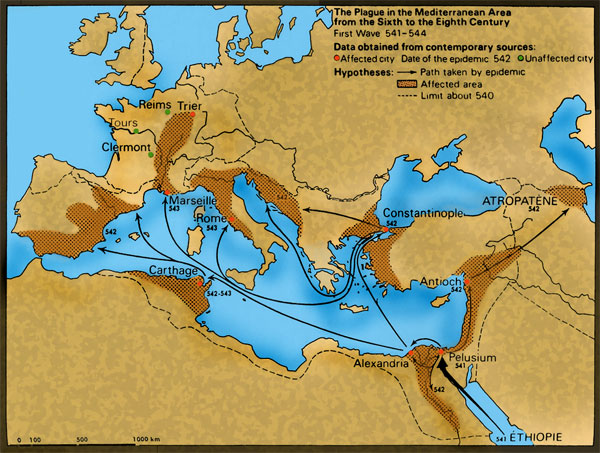
First Wave (541-544) of First Pandemic
| Major earthquakes in Italy | |
| Plague (second wave of first pandemic)
· recorded by scholar and historian, Agathias (536-580) |
|
| Plague (third wave of first pandemic)
· recorded by Gregory of Tours (539-594) |
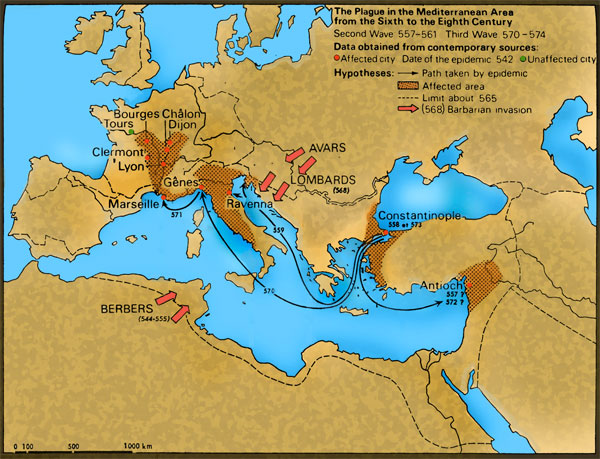
Second (557-561) and Third Wave (570-574) of First Pandemic
| Plague (fourth wave of first pandemic)
· with smallpox? |
|
| Plague (fifth wave of first pandemic)
· with smallpox? · recorded by Gregory of Tours |
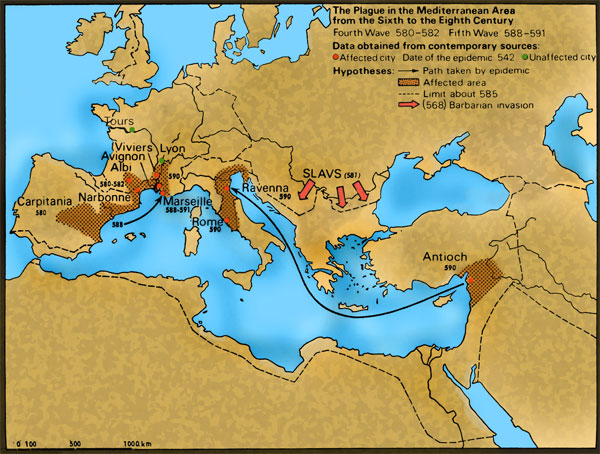
Fourth (580-582) and Fifth Wave (588-591) of First Pandemic
| Plague in Italy and France
· most lethal since Plague of Justinian · killed 15% of population |
|
|
|
Decline in European Population (500-750) |
|
|
|
The "Little Optimum" (750-1250) |
Relatively disease-free period marked by good climate:
The long series of optimal growing seasons were accompanied by an increase in population across Europe:
|
Not only was food more plentiful, but technological improvements -- many of them introduced into Europe from the East -- began making everyday work life less time-consuming and back-breaking:
This period saw the emergence of new forms of social and political organization:
As cities become overpopulated, settlements developed outside city walls All these changes gave rise to the growth of market and industry-based economy. |
|
"Little Ice Age" (1300-1850) |
Beginning around 1250, the world's climate began to cool, resulting in:
|
Famine years--1272, 1277, 1283, 1292, and 1311 |
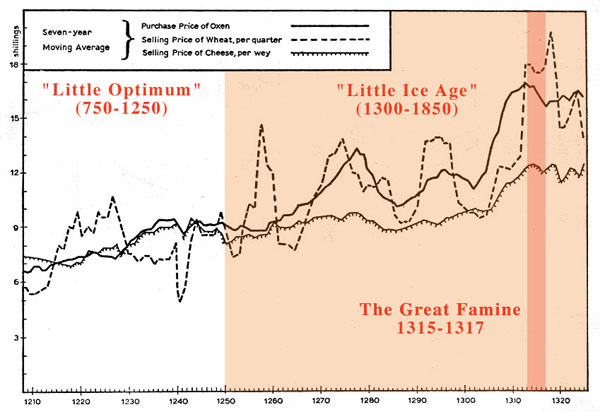
Accounts of the Great Famine of 1315-1317 |
| from Flanders:
...on account of the torrential rains and because the fruits of the earth were harvested in difficult conditions and destroyed in many places, there was a dearth of wheat and of salt ... the human bodies started growing weaker and disabilities developed.... So many people died every day ... that the air seemed to be putrefied ... miserable beggars died ... in great numbers in the streets, on dunghills.... --Abbot of St. Martin of Tournai |
| from England:
In the year of our Lord 1315, apart from the other hardships with which England was afflicted, hunger grew in the land.... Meat and eggs began to run out, capons and fowl could hardly be found, animals died of pest, swine could not be fed because of the excessive price of fodder. A quarter [8 bushels] of wheat or beans or peas sold for twenty shillings [four times the cost in 1313], barley for a mark, oats for ten shillings. A quarter of salt was commonly sold for thirty-five shillings, which in former times was quite unheard of. The land was so oppressed with want that when the king came to St. Albans ... it was hardly possible to find bread on sale to supply his immediate household.... ...The dearth began in the month of May and lasted until [September]. The summer rains were so heavy that grain could not ripen. It could hardly be gathered and used to bake bread ... unless it was first put in vessels to dry.... Bread did not have its usual nourishing power and strength because the grain was not nourished by the warmth of summer sunshine. Hence those who ate it, even in large quantities, were hungry again after a little while. There can be no doubt that the poor wasted away when even the rich were constantly hungry.... Four pennies worth of coarse bread was not enough to feed a common man for one day. The usual kinds of meat, suitable for eating, were too scarce; horse meat was precious; plump dogs were stolen. And, according to many reports, men and women in many places secretly ate their own children.... --Johannes de Trokelowe |
| from Italy:
The famine was felt not only in Florence but throughout Tuscany and Italy. And so terrible was it that the Perugians, the Sienese, the Lucchese, the Pistolese and many other townsmen drove from their territory all their beggars because they could not support them.... The agitation of the [Florentines] at the market of San Michele was so great that it was necessary to protect officials by means of guards fitted out with an axe and block to punish rioters on the spot with the loss of their hands and their feet. --Giovanni Villani |
| from France:
We saw a large number of both sexes, not only from nearby places but from as much as five leagues away, barefooted and maybe even, except for women, in a completely nude state, together with their priests coming in procession at the Church of the Holy Martyrs, their bones bulging out, devoutly carrying bodies of saints and other relics to be adorned, hoping to get relief. --Guillaume de Nages |
The Hundred Years War (1337-1453) and other civil disorders in Europe caused destruction of crops, of houses, and of life in general. |
 |
| Go to: |
|
|